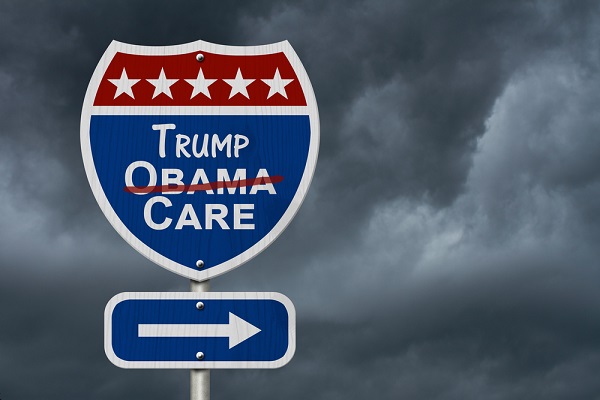
Authored by House Budget Chairman Steve Womack of Arkansas, theplan is set for a committee vote Thursday ahead of a possible Housefloor vote next week. (Photo: Shutterstock)
House Republicans unveiled a 2019 budget proposal Tuesday tosend a message to their core supporters that repealing Obamacare, cutting taxes andpartially privatizing Medicare remain high on their agenda.
|The budget, which claims to balance by 2027 through $8 trillionin spending cuts, seeks to revive the deficit-cutting mantle forRepublicans after a two-year deal that increased spending by $300billion. A massive tax cut approved last year is expectedto add $2 trillion in deficits over 10 years.
|Related: Trump administration won't defendObamacare
|The budget proposal lays out a platform for the Republicans torun on in November. Democrats need a net gain of 23 seats to winthe House and the party has reason to be optimistic about achieving thatgoal in November's election.
|The new measure would keep the 2019 discretionary spendinglevel, avoiding a showdown with Democrats that could lead toanother government shutdown. The plan calls for defense spendingincreases and cuts to domestic discretionary spending in lateryears.
|Authored by House Budget Chairman Steve Womack of Arkansas, theplan is set for a committee vote Thursday ahead of a possible Housefloor vote next week. The original deadline for adoption of aHouse-Senate budget was April 15.
|Womack said in a statement that even with “a booming economythanks to tax reform, there are real fiscal challenges casting ashadow of doubt on the nation's future, including $21 trillion ofdebt that is rapidly on the rise. We must overcome thechallenges.”
|Fast-track process
To win conservative support, the budget would fast-track atleast $302 billion in spending cuts over 10 years through a processthat requires only 50 votes to pass the Senate, avoiding aDemocratic filibuster, as long as the plan doesn't increasedeficits after 10 years. The same reconciliation process was usedin the failed attempt last year to repeal Obamacare and for thesuccessful passage of the tax-code overhaul.
|The budget would let congressional committees try once again torepeal the Affordable Care Act and enact a new tax law. The 2017tax law contained individual rate cuts that expire in 2026, andmany Republicans want to extend those in a new bill.
|“This budget assumes Congress repeals Obamacare and replaces itwith a patient-centered, free-market health care system,” thebudget summary states. It calls for a private Medicare “premiumsupport” system to compete with traditional Medicare, setting workrequirements for Medicaid, and for trimming other welfareprograms.
|While the Senate is unlikely to adopt its own budget to take upthese initiatives before the November congressional election, thebudget process could be used by lame-duck lawmakers after theelection to ram through Republican-only legislation.
|Spending objections
Republicans have felt heat from their political base over the$1.3 trillion omnibus spending bill passed in March that increasedmilitary and domestic spending. The backlash prompted PresidentDonald Trump to vow never to sign a similar bill. This week, theSenate plans a political-messaging vote on a White House-backedbill to cancel $15 billion in unspent funds.
|The budget's appearance, though, could bolster Democraticattempts to make the 2018 election about preserving Obamacare,which the minority party argues is increasingly popular. Democratsalso argue that the 2017 tax cut skewed benefits overwhelmingly tothe wealthy, making economic fairness an issue.
|“Democrats will make sure everyone knows that after providingmillionaires and corporations with massive tax breaks, HouseRepublicans decided to pay for it by once again calling for arepeal of the Affordable Care Act, ending Medicare as we know it,and offering deep cuts to investments in economic growth,” said theBudget Committee's top Democrat, John Yarmuth of Kentucky.
|Democratic Senatorial Campaign Committee spokesman DavidBergstein said this month that voters' concerns about rising healthcare premiums overwhelm any positive feelings about the overalleconomy, and that is a liability for Republican Senate candidates.Struggling for Votes
|Womack has struggled to round up votes on the Budget Committeefor his plan, so that could lead to drama this week in committeeand later on the House floor. Conservatives may be reluctant tovote for the 2019 spending levels set in the budget agreement withDemocrats early this year.
|Appropriations committees are using those spending levels todraft 12 spending bills in an attempt to enact them by the Sept. 30government shutdown deadline. Endorsement of the budget cap byHouse Republicans would be a strong indication that Congress may beable to avoid a shutdown over spending levels.
|The Trump administration's decision this month that it won'tdefend Obamacare in court could spur Congress to revisit the issuelater this year. The lawsuit by Texas challenging the law could gutthe law's protection for people with pre-existing medicalconditions. Were that to happen, the 2019 House budget wouldprovide a tool to revive the repeal attempt.
Complete your profile to continue reading and get FREE access to BenefitsPRO, part of your ALM digital membership.
Your access to unlimited BenefitsPRO content isn’t changing.
Once you are an ALM digital member, you’ll receive:
- Critical BenefitsPRO information including cutting edge post-reform success strategies, access to educational webcasts and videos, resources from industry leaders, and informative Newsletters.
- Exclusive discounts on ALM, BenefitsPRO magazine and BenefitsPRO.com events
- Access to other award-winning ALM websites including ThinkAdvisor.com and Law.com
Already have an account? Sign In







